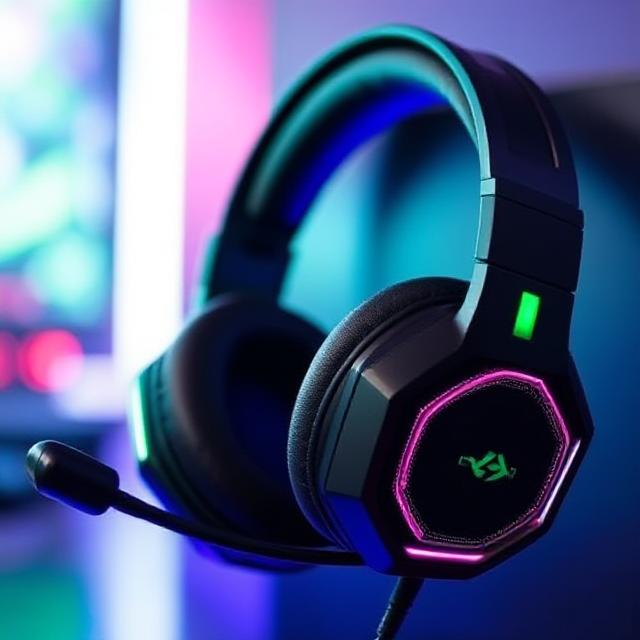How to Choose the Best Gaming Headphone
Introduction
Choosing the best gaming headphones is more than just picking the flashiest RGB-equipped headset on the market. Whether you’re an esports pro seeking pinpoint positional audio or a casual gamer who values comfort during marathon sessions, the right pair of headphones can elevate your gaming experience, improve your in-game performance, and even protect your hearing. This comprehensive 2,000-word guide will walk you through all the critical factors to consider—comfort, sound quality, microphone performance, connectivity, feature set, and budget—so you can make an informed decision and find the perfect gaming headphones for your needs.
Understand Your Gaming Profile
Before diving into specifications, ask yourself:
- Primary Game Genres: Do you play competitive FPS titles (e.g., Valorant, CS: GO) that demand precise positional audio, immersive RPGs (e.g., Elden Ring, The Witcher 3), or fast-paced MOBAs (e.g., League of Legends, Dota 2)?
- Play Environment: Do you game in a quiet room, a shared space, or with background noise?
- Session Length: How many hours per session? Comfort becomes paramount for extended play.
- Platform: PC, console (PlayStation/Xbox), mobile, or cross-platform? Compatibility varies.
- Budget Range: Under $50, $50–$150, $150–$300, or luxury/headset + DAC bundles?
Your answers will influence which features and specifications matter most.
Sound Quality: The Heart of the Experience
Driver Type and Size
- Dynamic Drivers: The most common in gaming headsets. They offer strong bass and wide frequency response.
- Planar Magnetic Drivers: Found in high-end headsets, they deliver faster transient response, tighter bass, and more detail, but come at a premium and are often heavier.
- Driver Size: Larger drivers (40–50 mm) typically produce more impactful bass and a fuller soundstage. For most gamers, 40 mm is an optimal balance of detail and power.
Frequency Response
- Standard Range: 20 Hz to 20 kHz covers human hearing. Some headsets extend beyond for a richer low end (<20 Hz) or crisper highs (>20 kHz), but these extensions are often subtle.
- Gaming EQ Profiles: Some headsets include software EQ presets (“FPS,” “RPG,” “Music”)—useful if you play multiple genres.
Soundstage and Imaging
- Virtual Surround Sound: Technologies like Dolby Atmos for Headphones or DTS Headphone:X simulate 7.1 surround—helpful for positional cues in competitive shooters.
- True Surround (Multi-Driver): Rare in headsets; separate drivers per channel for genuine surround accuracy, but can add weight and cost.
Open-Back vs. Closed-Back
- Closed-Back Headphones:
- Isolate external noise.
- Provide punchy bass but smaller soundstage.
- Better for noisy environments or streaming to avoid bleed.
- Open-Back Headphones:
- Offer a natural, spacious soundstage.
- Less bass impact and leak sound outward.
- Preferable for single-player immersion in quiet rooms.
Comfort and Build Quality: Marathons Made Bearable
Weight and Clamping Force
- Lightweight Designs (≤300 g): Reduce fatigue, especially during extended sessions.
- Balanced Clamping Force: Enough to stay on your head without pressure. Adjustable headbands help.
Earcup Materials and Size
- Memory Foam with Fabric: Breathable, less heat buildup.
- Protein Leather (PU Leather): Softer feel, better noise isolation, but can trap heat.
- Earcup Shape & Size: Over-ear (circumaural) for full coverage; on-ear (supra-aural) are generally less comfortable long-term.
Headband and Adjustability
- Padded headbands reduce pressure on the crown.
- Suspension or sliding headbands accommodate various head shapes.
- Metal sliders add durability; plastic can be fragile over time.
Durability and Build Materials
- Reinforced Plastics vs. Metal Frames: Metal lasts longer but can increase weight.
- Detachable Cables and Replaceable Parts: Extends lifespan; look for modular designs where ear pads or headbands can be swapped.
Microphone Performance: Clear Communication Is Key
Microphone Types
- Boom Microphones: Closest to your mouth, best clarity, and noise rejection.
- Retractable/Built-In Mics: Convenient but often lower fidelity.
- Detachable Mics: Flexible—remove for music listening or portability.
Pickup Patterns
- Unidirectional/Cardioid: Captures sound from the front (your mouth), rejects ambient noise—ideal for gaming.
- Omnidirectional: Picks up sound from all around—good for group chats but more background noise.
- Noise-Cancelling Mics: Use physical or digital filters to suppress keyboard noise, fan noise, and room ambience.
Mute and Monitoring Features
- Quick-Access Mute Button/Switch: Prevent accidental shouting.
- Mic Monitoring (“Sidetone”): Lets you hear your own voice—avoids over-talking into the mic.
Connectivity: Wired vs. Wireless
Wired Headsets
- 3.5 mm Analog: Universal compatibility (PC, console, mobile). No latency; no batteries.
- USB Headsets: Offer digital audio, customizable EQ via software, and often virtual surround. Requires USB port.
Wireless Headsets
- 2.4 GHz RF Dongle: Low latency, high reliability. Requires a USB dongle; range typically 10–15 m.
- Bluetooth: Convenient for mobile, laptops; higher latency—not ideal for competitive gaming, but multipoint pairing.
- Battery Life: Look for 20+ hours of playback; fast-charging features are a bonus (e.g., 15 min for 3 hours).
- Drivers and Charging: Understand charging port type (USB-C preferred) and battery replacement options.
Hybrid Headsets
- Some models offer both wired and wireless modes—use wired for critical, low-latency play and wireless for casual sessions.
Platform Compatibility and Software Ecosystem
Console vs. PC
- PC-Only Features: Advanced EQ, surround sound, firmware updates via proprietary software.
- Console Compatibility: Ensure the headset works natively with PlayStation, Xbox, or Nintendo Switch—some features require license (e.g., Sony’s Tempest 3D AudioTech).
Cross-Platform Flexibility
- Mobile Support: If you game on smartphones/tablets, check for 3.5 mm or Bluetooth support.
- Universal Dongles: Dongles compatible across Windows, Mac, PS5, Xbox Series X/S, Switch dock.
Software Suites
- Customization: EQ presets, RGB lighting controls, mic settings, surround toggles.
- Firmware Updates: Essential for bug fixes, performance improvements.
- Cloud Profiles: Save your settings and load them on different machines.
Special Features and Extras
RGB Lighting and Aesthetics
- Braided vs. Rubberized Cables: Braided cables resist tangling and last longer.
- Adapters: 3.5 mm to dual 3.5 mm for PC soundcard, mobile inline controllers.
Swappable Ear Pads and Headbands
- Variety Packs: Some brands include both protein leather and velour ear pads.
- Aftermarket Options: Third-party manufacturers often offer upgraded pads for improved comfort or isolation.
Passive Noise Isolation vs. Active Noise Cancellation (ANC)
- Passive Isolation: Achieved by earcup design/material—blocks mid/high frequencies well.
- ANC: Uses microphones and DSP to cancel low-frequency noise (fans, air conditioners). Rare in gaming headsets but useful for traveling.
Budget Considerations
| Budget Tier | Expected Features |
|---|---|
| Under $50 | Basic dynamic drivers, 3.5 mm wired, plastic build, basic mic, minimal padding |
| $50–$150 | Larger drivers, USB/3.5 mm hybrid, better padding, detachable mic, basic surround DSP |
| $150–$300 | Wireless variants, enhanced drivers (40–50 mm), virtual surround, RGB, premium build, software suite |
| $300+ | Planar magnetic or multi-driver true surround, premium materials, ANC, swappable parts, high-end DACs |
Be realistic: diminishing returns set in beyond $200–$250 unless you have very specific audiophile or pro needs.
Top Brands and Models to Consider
While new models release frequently, the following brands consistently deliver quality across budgets:
- Budget (≤$100): HyperX Cloud Stinger, Corsair HS50, Razer Kraken X.
- Mid-Range ($100–$200): SteelSeries Arctis 7X, Logitech G Pro X, Razer BlackShark V2.
- High-End ($200–$300+): Sennheiser GSP 600, Audeze Maxwell, Beyerdynamic MMX 300.
- Wireless Premium: SteelSeries Arctis Nova Pro Wireless, Corsair Virtuoso RGB Wireless XT.
- Open-Back (PC Only): Sennheiser Game One, Beyerdynamic DT 990 Pro (with mod mic).
Testing and Trial
- Return Policies: Buy from retailers with generous return windows (30 days or more).
- In-Store Trials: If possible, try on headsets to gauge fit and pad comfort.
- User Reviews and Forums: Look for feedback on long-term comfort, build durability, and driver longevity.
- Audio Samples: Listen to test tracks (bass-heavy, vocal clarity, ambient sounds) to assess tonal balance.
Maintenance and Care
- Cleaning: Wipe ear pads and headband with a damp cloth. Allow to dry fully.
- Storage: Use a headset stand or hanger to avoid crushing ear cups.
- Cable Management: Detach cables when not in use; avoid tight bends.
- Firmware Updates: Periodically check manufacturer software for updates.
Final Checklist
Before completing your purchase, ensure your chosen headset ticks these boxes:
- Fits Comfortably: Adjustable headband, breathable ear pads.
- Sound Profile Matches Your Games: Clear mids for voice chat, tight bass for explosions, crisp highs for footsteps.
- Mic Meets Your Needs: Cardioid pattern, noise rejection, mute functionality.
- Connectivity Works Across Devices: 3.5 mm, USB, wireless dongle, Bluetooth.
- Software Ecosystem: EQ, surround sound options, customizable lighting.
- Budget Alignment: Optimal value without overspending on unneeded extras.
- Warranty & Support: At least 1–2 years coverage and responsive customer service.
Conclusion
Investing time to research and compare gaming headphones based on your personal gaming habits, comfort requirements, sound preferences, and budget will pay dividends in both performance and enjoyment. From crystal-clear positional audio in competitive shooters to lush, expansive soundscapes in RPG epics, the right headset can become the linchpin of your immersive gaming world. Armed with this guide’s in-depth look at drivers, mic technology, build quality, connectivity, and more, you’re now ready to zero in on the best gaming headphones that match your unique profile. Happy gaming!
A passionate tech enthusiast with a deep interest in the latest innovations, gadgets, and emerging technologies. Always eager to explore cutting-edge hardware and software, I enjoy sharing insights, reviews, and recommendations to help others make informed decisions in the ever-evolving tech world. With a curious mindset and hands-on approach, I stay up-to-date with industry trends, from PCs and gaming to mobile devices and AI-driven tools.







